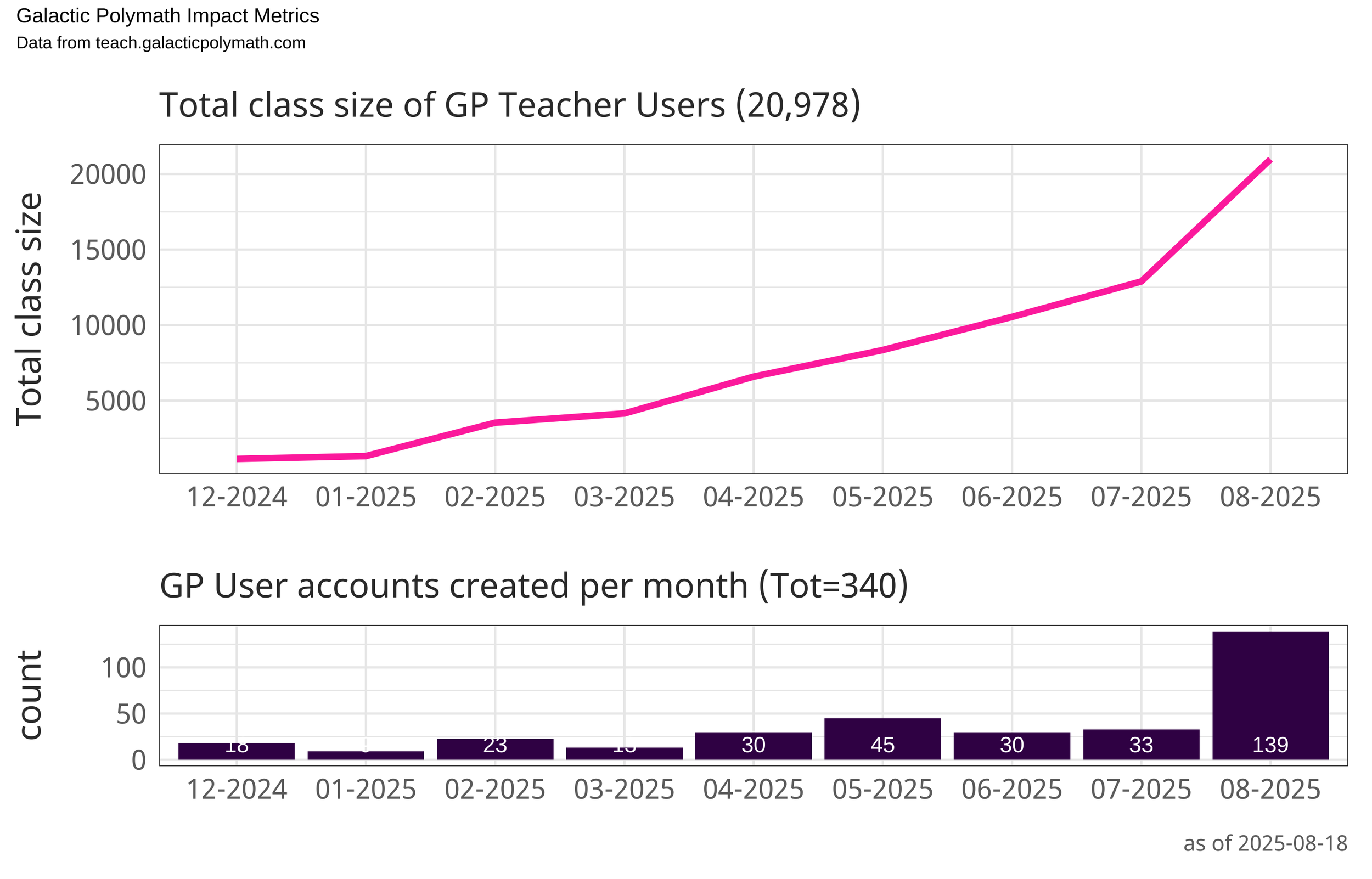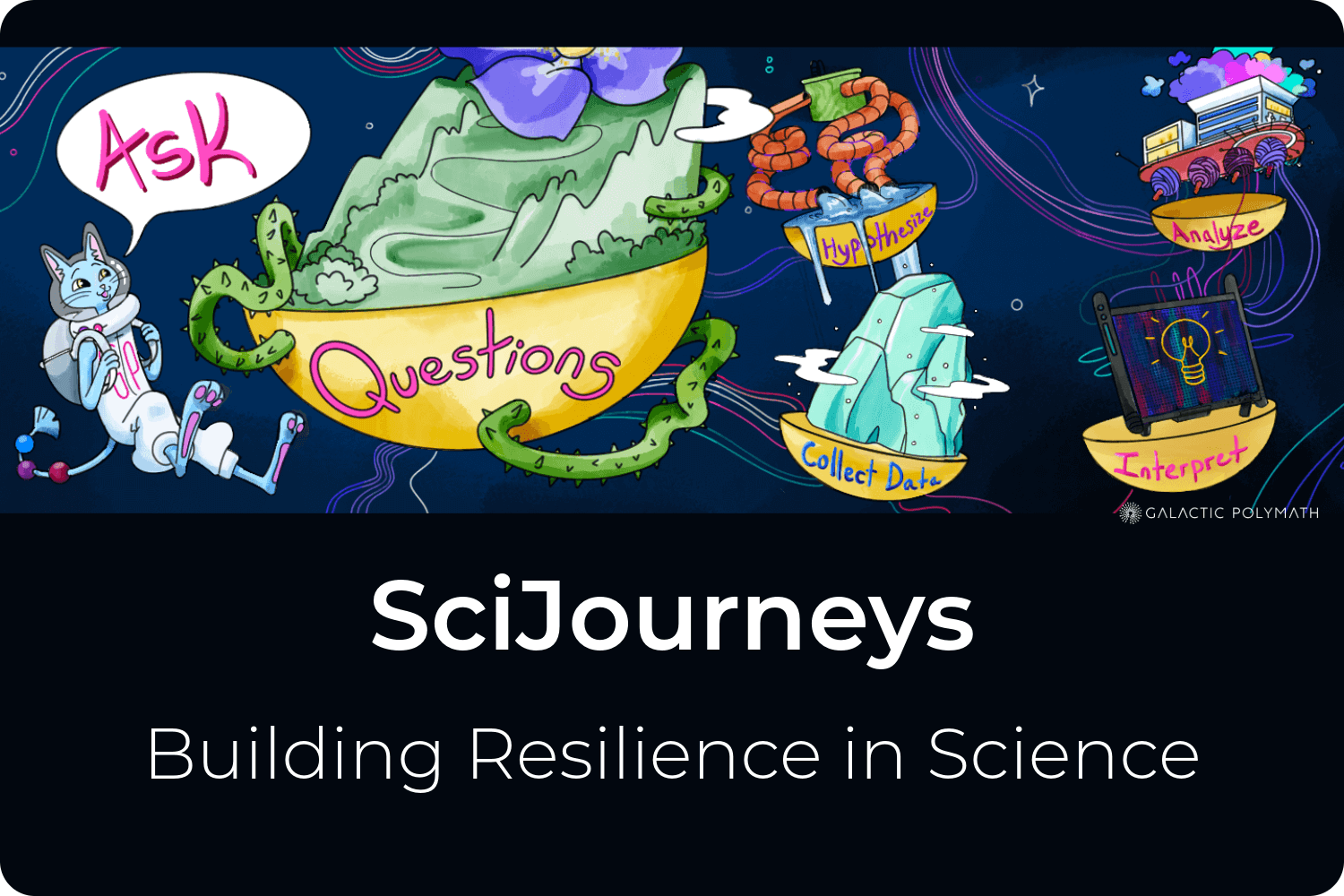Win Cash, Save Science: Share Your SciJourney!
Updated 10/14/2025: Now accepting late submissions until Nov 3 11:59pm!
Voting is open! Click here for the video playlist and resources for connecting scientists to your classroom.
#MySciJourney Competition Details
We’re looking for scientists at all stages to share their journeys in science!
Communicating science cannot be an afterthought. Public funding for research depends on public engagement and support. But to appreciate the power and promise of science, people need a deeper, more nuanced understanding of the processes of science. As practicing scientists know, authentic research is much more varied, dynamic, and creative than the scientific method most of us encountered in school.
Science historian, educator, and IF/THEN Ambassador Jocelyn Bosley approached Galactic Polymath with a vision to enrich the ways we think, talk, and teach about how science works. That’s why we created the SciJourneys framework—a reimagining of the scientific method that better reflects the complex, multitudinous paths of scientific research, presented with a playful, choose-your-own-adventure aesthetic. This framework is at the center of our unit for grades 6-8+ called “SciJourneys: Building Resilience in Science.” It’s also at the center of this competition, which aims to produce a large repository of short, social-media-friendly videos to give the public a window into the real work of science.
The SciJourneys “World Map”—an alternative framing of the scientific method as a choose-your-own-adventure with Communication at the center.
What? An award for scicomm?!
Science communication (#scicomm) requires a blend of expertise, language skills, empathy, and creativity, and it often goes under-appreciated. That's why we created the 2025 #MySciJourney Challenge!
Winners will not only get a rare science communication award to add to their CVs, but they will also help teachers and students across the US, as well as the general public, understand what’s at stake and what we stand to lose by the current efforts to undermine US scientific funding agencies. Winners will also get the opportunity to have their story featured on the Smart Tea Podcast!
We are looking for scientists at all stages (high school and undergraduate lab assistants all the way to full professors) to share your journeys in science! Cash prizes will be awarded to first ($500), second ($300), and third ($200) place for videos with the most likes across Galactic Polymath’s YouTube and Instagram.
Tell me more!
We are able to offer cash prizes thanks to our lead sponsor—the National Center for Science Education—and contributions from Civic Science Media Lab and us (Galactic Polymath). We are also grateful to our dissemination partners: the Association of Science Communicators and LabXchange!
Science is way more fun, creative, and human than the scientific method typically taught in school. In fact, I would argue that there is no single scientific method. Instead, there is a set of processes (Ask Questions, Hypothesize, Collect Data, Analyze, Interpret) that scientists rely on as they navigate the adventure of real-life research, repeating and remixing steps as needed.
At the center of these scientific processes is Communication. While not typically included in the scientific method, communication is key to science at every stage—we share our questions, hypotheses, data, and early interpretations with labmates, colleagues, and mentors throughout our investigations, and their feedback plays a crucial role in how the research progresses.
In your #MySciJourney submission, you must use our SciJourneys framework and slide template, but you can focus on any step(s) you choose. The goal is to convey who you are and what authentic research is actually like. Some things you might share:
What are your research questions?
How did you come up with them?
How do you answer them?
Why is communication essential to science?
How are you affected by efforts to defund and disassemble scientific agencies in the United States?
Submission details
Format: A 2-3 minute recorded presentation as a vertical video. Check out these examples (Matt’s is not considered part of the competition).
Basic Requirements:
Must use our SciJourneys Slides template (see detailed requirements).
Must be ≤ 3:00 minutes
Must be a vertical (portrait) video (1080px wide x 1920px tall)
Original Deadline: October 12, 2025 (all accepted submissions to date are posted here)
Late Submissions: You can still add your SciJourney to our growing repository to inspire and inform the public! If you submit between Oct 12 and Nov 3, we will add new accepted videos to the top of the playlist as they come in (to boost your views).
Audience: 12 years old and above
Tone: Lively, approachable, authentic
Use of your video: When you share your video through the submission form linked in the Procedure below, we will evaluate the quality and fit of your video for our target audience. If the committee does not deem it a good fit, we may not include it in our library—though of course, you may choose to share it with your own network.
If your video is accepted, we will add it to the SciJourneys collection on Galactic Polymath’s YouTube and we will promote it through our partner networks. You will maintain copyright over your work. In the video submission form, we will ask for your permission to post your video on our social media platforms and for the funding organizations to be allowed to edit/remix this content for the purpose of STEM education, engagement, and advocacy.
Teachers, want early access to the submitted videos and to participate in voting? 👉
Help us get to 50,000 students!
We want teachers across the US and around the world to have access to our free materials and to see the SciJourneys of real scientists!
Share this blog to help spread the word and grow our collective classroom audience!
Detailed Requirements and Resources
We made a Google Slide Template with beautiful layouts to make this easier for you!
(Required) Use the Presentation Template: For continuity, we’d like you to use the SciJourneys map and aesthetics, but you are welcome to rearrange the order and add your own images and video. Create your own slideshow presentation with the SciJourneys Template (Click “Use Template” to copy to your Google Drive) or (Download PPTX)
Important: The #MySciJourney examples from Matt & Allison were made by screen recording while presenting the Google Slides presentation with a paid Google Workspace account. This allows the Speaker Spotlight bubbles to show up on slides in specific areas, which is nice, but not possible if you have a free Gmail account or if you download to Powerpoint.
It is highly recommended that you do embed video of your face in the presentation, as this will build greater viewer engagement. This will be easiest if you can use Google Slides under a paid Workspace account, but is possible with a number of other applications like Tella (see below) that let you place your camera image on the screen recording when editing the video.
(Recommended) Watch our introductory video introducing SciJourneys to get a sense for the nonlinear scientific methods framework and tone we’re looking for.
(Optional) Shoot us an email to express your interest in submitting. We will keep you informed about any changes, updates, or advice for submissions. While we can’t do troubleshooting for everyone one-on-one, if you share questions or issues, we will try to update this document and alert folks to potential solutions for common challenges.
(Optional) Use this script template (Google Docs / DOCX). Draft your script before you even start the slideshow to help lay out your narrative and get feedback from others about diction/jargon, effectiveness of hooks, and amount of content.
Procedure:
Build your slideshow with the template above.
Practice, perform, revise, practice, perform, revise.
Make sure you have a good, quiet setup for recording with the best microphone and natural lighting available.
Present locally on your computer (ideally using Google Slides with Speaker Spotlight to show your face in the presentation)
Record your screen and microphone audio in vertical HD video format (see below for tips)
Edit the video if necessary to tighten up performance, add sounds, and make sure it’s as short as possible within the 3 min limit
Export to MP4 as (1080x1920)…make sure you’re not exporting to wide format with black margins on the sides…it must be a vertical video.
Submit your MP4 with the button below!
Recommended applications: Most screen recording programs will want to record in HD wide format (1920x1080). You’re going to need a program that lets you record natively in portrait (1080 x 1920) or manually select the vertical area on your screen as you’re presenting.
Tella is a great option for screen recording across operating systems! They also have a 6 month free plan for educators. We especially appreciated the really efficient text-based-editing that allows you to auto-transcribe text from your speech and delete sections of video based on the transcriptions. Super cool! Also allows you to easily add captions to the video like I did here.
Allison used OBS to record her video here. This is also a nice tutorial for using OBS to record vertical video.
On a Mac, Quicktime can work, as shown here.
Good luck!
We can’t wait to see your video and learn about your SciJourney! Let us know your thoughts or questions in the comments.
FAQs
-
-
In the words of the surf instructor from Forgetting Sarah Marshall: Do less. You may notice that in both Matt & Allison’s examples, they’re talking pretty fast for the whole 3min. Feel free to cover less territory and focus on 1 smaller part of your scijourney (a specific experiment or career stage) that you feel will resonate with viewers.
Minimize text! Use fewer words and larger text than you would for a typical scientific talk. Try to read every word on your slide so the viewer’s not dividing their attention.
Add visuals! Show your face frequently on the slides (take advantage of Speaker Spotlight in Slides or manually capture your face and add in postproduction editing). It will make this a much more personal and effective video.
Add other media! Pictures and video of you and your labmates in the lab, field; show your study system—this will bring your words to life.
Insert a slide now and again that is just you talking to the camera. This can be a very effective way to refocus the audience—particularly when you want to make an emotional/personal point.
-
Get a wired microphone! Sound is a super important part of this. Also, if you’re using Adobe Express or Adobe Premiere for editing—apply a vocal enhancer. These have become quite effective and easy to use. Lots of videos on YouTube can give you guidance.
Get good lighting. Avoid harsh overhead lights. Set yourself up near a window that lets in diffuse front lighting. Here’s a great video with tips from Wirecutter.
Practice and revise! Record a dry run, expecting to do it again. Show it to someone. Incorporate feedback to make it shorter, less complicated, more emotive. We needed about 3 different cuts to make the final examples.




